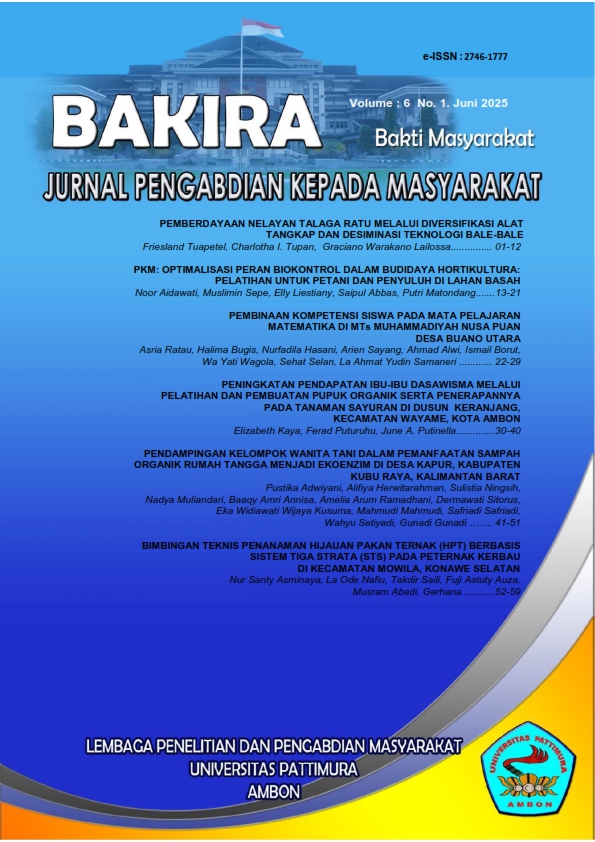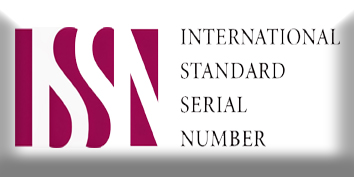PELATIHAN TEKNIK BUDIDAYA PALA DI NEGERI WATUI KECAMATAN ELPAPUTIH KABUPATEN SERAM BAGIAN BARAT
Abstract
Indonesian nutmeg is preferred by the world market, because it has several advantages compared to nutmeg from other countries, the advantages include high oil yield and a distinctive aroma. In Negeri Watui, the majority of people work as farmers and show considerable interest in cultivating nutmeg plants. This interest is not only driven by the economic potential of nutmeg plants, but also by the availability of supporting agricultural land and easy access to seeds. However, the limited knowledge of the community about nutmeg cultivation techniques makes them hesitate to start. One of the main obstacles is the assumption that nutmeg cultivation techniques are quite complicated, especially in terms of selecting superior seeds, creating shade, arranging the right planting distance, and maintenance such as pruning, embroidery, and fertilization which require special technical precision and understanding. Therefore, this training was carried out to answer the community's need for adequate technical knowledge and build self-confidence in cultivating nutmeg plants sustainably. And they really hope for training on how to cultivate nutmeg plants so that it can increase the knowledge of farmer groups about nutmeg cultivation and foster the community's interest in creativity related to the development of natural resources.
Downloads
References
Astanu, D. A., Ismono, R. H., & Rosanti, N. 2013. Analisis kelayakan finansial budidaya intensif tanaman pala di Kecamatan Gisting Kabupaten Tanggamus. Jurnal Ilmu Ilmu Agribisnis: Journal of Agribusiness Science, 1(3), 218-225.
Balai Penelitian Tanaman Rempah dan Obat. 2009. Panduan Budidaya Tanaman Pala. Bogor: Badan Penelitian dan Pengembangan Pertanian.
Departemen Pertanian. 2008. Teknik Budidaya dan Pasca Panen Pala. Jakarta: Direktorat Jenderal Perkebunan.
Hairiah, K., Dewi, S., & van Noordwijk, M. 2011. Agroforestry sebagai Pendekatan untuk Pembangunan Pertanian Berkelanjutan. Bogor: World Agroforestry Centre (ICRAF) SEA.
Hardiyanto, E. B., & Sastrosiswojo, S. 2010. Petunjuk Teknis Budidaya Tanaman Pala. Malang: Balai Penelitian Tanaman Perkebunan.
Irwanto, I., Hatulesila, J. W., Talaohu, M., & Ely, A. S. 2022. Kombinasi jenis tanaman pola Dusung pada berbagai ketinggian tempat di Negeri Luhu Seram Barat. Jurnal Hutan Pulau-Pulau Kecil, 6(1), 94-108.
Kartasapoetra, A. G. 1991. Teknologi Budidaya Tanaman Perkebunan: Panduan Lengkap. Jakarta: Bumi Aksara.
Legoh, W. L., Kojoh, D., & Runtunuwu, S. 2017. Kajian Budidaya Tanaman Pala (Myristica fragrans Houtt) di Kabupaten Kepulauan Sangihe. In Cocos (Vol. 8, No. 4).
Parimin, R. 1996. Potensi dan Prospek Budidaya Tanaman Pala di Indonesia. Jakarta: Penebar Swadaya.
Purwanto, Y., & Sunaryo, D. 2006. Teknik Pemeliharaan dan Pengelolaan Tanaman Pala di Indonesia. Yogyakarta: Gadjah Mada University Press.
Ruhnayat, A., & Martini, E. 2015. Budi Daya Pala pada Kebun Campur. Balai Penelitian Tanaman Rempah dan Obat.
Sampulawa, D., Tuharea, J., & Gaite, T. 2023. Implementasi Bantuan Langsung Tunai Desa Terhadap Masyrakat Ekonomi Lemah di Dusun Lirang Desa Luhu. Journal of Education Technology Information Social Sciences and Health, 1(1), 87-99.
Saragih, B. 2012. Pengembangan Agribisnis Rempah: Strategi dan Implementasi. Bogor: Pusat Kajian Agribisnis IPB Press.
Siregar, M., & Parulian, S. 2015. Teknologi Budidaya Tanaman Pala yang Efisien dan Produktif. Jurnal Agronomi Tropika, 14(2), 34-42.
Suprapto, A., & Tjahjadi, A. 2009. Budidaya dan Pemanfaatan Hasil Olahan Pala. Jurnal Hortikultura, 3(1), 12-20.
Copyright (c) 2025 Andjela Sahupala, Troice Siahaya, Juglans H. Pietersz

This work is licensed under a Creative Commons Attribution-NonCommercial-ShareAlike 4.0 International License.













